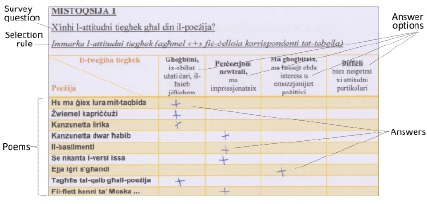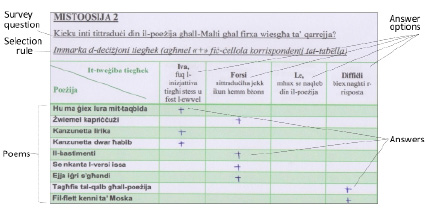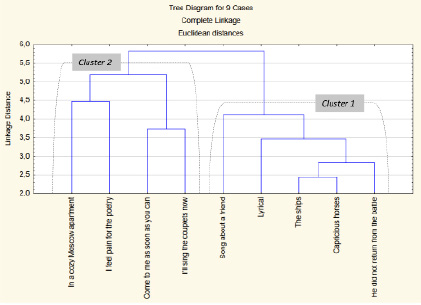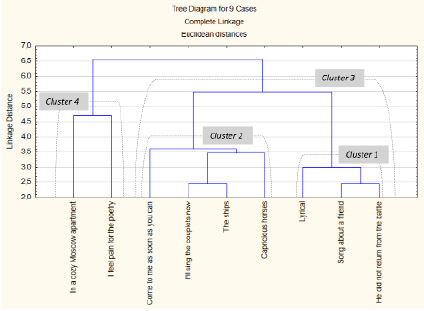Introduction
A comprehensive study of the problems of the correctness of the choice of a specific poet’s works for translation, the level of adequacy of the translation is not only a relevant but also a non-trivial task. We believe that the approach to solving these problems proposed by the author of the article based on the results of translating thirty-six texts by the Russian poet Vladimir Vysotsky into Maltese is of particular interest [1, p. 67-76; 2, p. 171-173; 3].
Since the author of the article is currently the only translator of Vysotsky from Russian into Maltese, the evaluation of the translations causes difficulties in applying the methods of comparative analysis known to translators. These methods work in cases where there are many translations into a certain language, completed by different translators, and research interest in them is shown. This is the case in Poland, Bulgaria, Hungary, the Czech Republic, Ukraine, the USA and other countries. Similar conditions have not yet formed in Malta, which necessitated the search for a different approach to the evaluation of Maltese translations. The approach should serve to verify the degree to which Vysotsky’s poetry has been received in the public environment of Malta. Consequently, it is reasonable to turn directly to the ‘public environment’ itself. The method of expert evaluation, used, among other things, in sociological research with a survey of specialists in a certain field, will help in this.
Objectives of the study. The goal of the expert survey is subordinated to the main goal of the translation – achieving maximum adequacy of the reception of Vysotsky’s poetry in the public environment of Malta and is formulated as follows: ensuring verification of the correctness of the choice and adequacy of the translation of poems into Maltese based on their reception by experts.
The implementation of the survey objective involves solving the following tasks:
Problem 1. Determining the adequacy of the translation of Vysotsky’s poetry into Maltese by comparing the existing affiliation of poems to the groups ‘Top Series’ and ‘Lower Series’ with their affiliation obtained from the reception of experts.
Problem 2. Determining the correctness of the choice of Vysotsky’s poems for translation by comparing the translation choice of the author of the article, reflected in the composition of the poems of the ‘Top Series’ with the translation preferences of experts.
Materials and methods of research
The application of the expert evaluation method is facilitated by the unique conditions created by a significant representation of Vysotsky’s poetry on the Internet. One of the most famous is the website ‘Vladimir Vysotsky in different tongues’ (https://wysotsky.com/).
Table 1
Fragments of the table ‘Vladimir Vysotsky in different tongues. Translated poems’ (Website ‘Vladimir Vysotsky in different tongues’[Accessed 20 January 2019])
|
Ten first poems |
Ten last poems |
|
I don’t like |
I feel pain for the poetry |
|
Capricioushorses |
In a cozy Moscow apartment ... |
|
He did not return from the battle |
Vasily does not study at the institute ... |
|
Lyrical |
It’s vacation now .... |
|
Song about a friend |
To Kokhanovsky |
|
The ships |
To Uteevsky |
|
Wolf hunting |
In the light of day ... |
|
Mass graves |
There was an episode in ancient history ... |
|
My gypsy song |
Come to me as soon as you can |
|
Song about the Earth |
I’ll sing the couplets now |
Table 2
Corpus of author’s translations of poems – objects of expert survey
|
Group‘ТорSeries’ |
Group‘Lower Series’ |
|
He did not return from the battle |
I’ll sing the couplets now |
|
Capricioushorses |
Come to me as soon as you can |
|
Lyrical |
I feel pain for the poetry |
|
Song about a friend |
In a cozy Moscow apartment ... |
|
The ships |
- |
The basis that makes it possible to conduct our study is the general table of translated texts on the website ‘Vladimir Vysotsky in different tongues. Translated poems’ (https://wysotsky.com/0002/002.asp). At the time of writing this article, the table contained about 800 lines with poems, arranged from its beginning in descending order of the number of translations of each of them.
From this general table we will select the first ten texts – with the largest number of translations, and the last ten texts, which have one or two translations(Table 1).
Then we will form a table consisting of a number of translations of poems by the author of the article. It is they, included in the first and last ten texts, that will be the objects of the expert survey (Table 2). We will designate the first group (left column of the table) conditionally as ‘Top Series’, the second group (right column of the table) we will call ‘Lower Series’.
Table 2 shows that the number of poems included in the table in the translation of the author of the article – objects of the expert survey – is 9 texts, which corresponds to the pattern called ‘Miller’s Number –7 ± 2’ [4, p. 82-96]. This number of poems serves to minimize erroneous assessments.
Let us put forward the following hypotheses corresponding to the problems set:
Hypothesis 1. The adequacy of the translation of the poems into the Maltese language is evidenced by their continued belonging to the ‘Top Series’ and ‘Lower Series’ according to the results of an expert survey.
Hypothesis 2. The correctness of the choice of the works of the ‘Top Series’ group by the author of the article for translation into Maltese is evidenced by the manifestation of the preferences of experts in the selection of works for translation in the interests of the general public of the target language.
Next, we form an expert group, which involves determining the qualitative and quantitative composition of the group, necessary and sufficient to achieve the reliability of the survey results. The following requirements for a potential member of the expert group were taken into account: is a native resident of Malta – a bearer of the corresponding picture of the world and the Maltese language; has the necessary competencies in the field of translation; has an academic degree in the humanities; is independent of the results in the assessed field; has the ability to think creatively. We selected 14 master’s students of the Department of Translation, Terminology and Interpreting Studies, Faculty of Arts, University of Malta as experts.
Based on the conditions of our study, a face-to-face expert survey was chosen. The questionnaire contains closed questions that require choosing one of the proposed alternative answers for each poem. The first question of the questionnaire is designed to determine the reception of poems by experts from the position of the reader and sounds like this:‘What is your attitude towards the poem?’ Experts must choose one of the following alternatives:
• I liked it, the poet’s images are familiar, the thoughts are clear.
• Neutral attitude, did not make much of an impression.
• I did not like it, did not arouse interest and positive emotions.
• I find it difficult to give an assessment.
It is necessary to clarify what semantic load each of the answer options carries and the role that it is called upon to play in our study. We believe that the option ‘I liked it, the images of the poet are familiar, the thoughts are clear’, the expert will choose in the case when the artistic concept of a particular poem, firstly, is equivalently interpreted by him, and secondly, is ‘close enough’ to him emotionally. The option ‘Neutral attitude, didn’t make much of an impression’ is chosen in the case of an equivalent understanding of the artistic concept of a particular poem, but the latter did not find sufficient ‘reflection in the soul’ by the expert. The answer ‘I didn’t like it, didn’t arouse interest and positive emotions’ does not evoke vivid impressions from the expert, but at the same time he quite imagines a certain artistic concept laid down by the poet in this poem. Finally, the ‘difficult to assess’ option. This option is intended, according to the author of the study, to show that the artistic concept of this poem ‘escaped’ the expert’s understanding due to its cultural specificity and the lack of analogues in the expert’s picture of the world on the whole.
The second question of the questionnaire is designed to identify the translation reception of poems by experts, to show empathy towards the target recipient of the translation and is formulated as follows: ‘Would you translate the poem into Maltese for a wide range of readers?’ It is important to note that the target audience is clearly defined here – ‘a wide range of readers’. Alternative answers to which are as follows:
• Yes, on my own initiative and among the first.
• Maybe I will translate if the need arises.
• No, I will not translate this poem.
• I find it difficult to answer this question.
The expert chooses the option ‘Yes, on my own initiative and among the first’ if he really liked the poem. He is ready to translate it without any order from anyone, since he quite confidently imagines that the general public of the Maltese society will be happy to get acquainted with this work, noting with gratitude the work of the translator. The variant ‘I can translate, if the need arises’ contains the following meaning: the work did not find a sufficient ‘response’ in the soul of the translator, and he has some doubts about the possibility of a high emotional reaction to the translation of the poem, leaving the translation to his own discretion. When choosing the option ‘No, I will not translate this poem’, it is obvious that the expert not only did not like the poem, but it will not arouse any interest among readers. Finally, the ‘Difficult to answer the question’ option raises doubts about understanding of the artistic concepts of the works.
The further course of solving the survey problems involves the use of mathematical methods for the analysis of expert assessments. But the experts, when answering the questionnaires, put down the ‘+’ symbol to the chosen answer. This method of designating the selected option was used in order to avoid possible errors when the experts put down the values in the ranks. Here are examples of the questionnaire tables filled out by experts (in Maltese). They are shown in Figure 1 and Figure 2.
For subsequent processing of the experts’ answers to the questions, it is necessary to perform certain transformations and procedures. After that, the data in rank form for the answers to the questionnaire questions selected by the experts are prepared for further mathematical processing.
The process of solving the examination tasks involves identifying groups into which poems are distributed based on the results of the expert assessment, which will be provided to us by the Cluster Analysis apparatus. The main purpose of cluster analysis is to divide the set of objects under study into homogeneous groups or clusters in the corresponding sense. Cluster Analysis includes a set of different classification algorithms and helps the researcher to present the observed data in a visual form. Cluster analysis is widely used in sociological research.

Fig. 1.An example of a completed table for the first question

Fig. 2. An example of a completed table for the second question
Results of the research and discussions
Let us present the solution to problem 1 (hypothesis 1). As we remember, the statement of problem 1 is as follows: Determining the adequacy of the translation of Vysotsky’s poetry into Maltese by comparing the existing affiliation of poems to the groups ‘Top Series’ and ‘Lower Series’ with their affiliation obtained from the reception of experts.
To solve it, experts answered the first question: What is your attitude to the poem? This question is designed to determine the reception of the expert as a reader. The dendrogram looks like this (Figure 3).
As a result, we got two distinct clusters: Cluster 1, which included all the poems of the ‘Top Series’ and Cluster 2, which included the ‘Lower Series’ poems. Previously, all the poems of the ‘Top Series’ group were united in their cluster, having most of the answers chosen by the experts with the same and high ranks. They are ‘The ships’, ‘He did not return from the battle’, ‘Capricious horses’, ‘Lyrical’, ‘Song about a friend’. Later, another cluster was formed by all the poems of the ‘Lower Series’: ‘I’ll sing the couplets now’, ‘Come to me as soon as you can’, ‘I feel pain for the poetry’, ‘In a cozy Moscow apartment’.
Thus, hypothesis 1 –That the adequacy of the translation of the poems into the Maltese language is evidenced by the preservation of their belonging to the ‘Top Series’ and ‘Lower Series’ groups according to the results of an expert survey – is confirmed.

Fig. 3. Dendrogram for the first question of the questionnaire (Stat. TVA, TIBCO Soft. Inc.)

Fig. 4. Dendrogram for the second question of the questionnaire (Stat. TVA, TIBCO Soft. Inc.)
Finally, we will show the solution to problem 2 (hypothesis 2). Let us recall the formulation of problem 2: Determining the correctness of the choice of Vysotsky’s poems for translation by comparing the translation choice of the author of the article, reflected in the composition of the poems of the ‘Top Series’ with the translation preferences of experts.
To solve it, the experts answered the question: ‘Would you translate the poem into Maltese for a wide range of readers?’ This question is intended to determine the experts’ translation reception.
The dendrogram looks like this (Fig. 4). Even a simple visual comparison of the clusters of the first (Fig. 3) and second (Fig. 4) dendrograms shows a certain similarity and significant difference. The results can be interpreted as follows. The experts showed a developed sense of empathy towards the interests of the ‘general public’. First of all, they chose to translate poems with concepts that are understandable and close to all people: ‘friendship’, ‘love’, ‘death’ (Cluster 1).
Experts did not rule out the possibility of translating poems from Cluster 2. In this regard, the fact that Cluster 1 and Cluster 2 merged into a single Cluster 3 is indicative. But why did ‘The ships’ and ‘Capricious Horses’ from the ‘Top Series’ end up among the poems of Cluster 2? The experts’ choice is understandable: these poems will be popular with a special stratum of readers, but not with the general public. The explanation for this is their great existential charge, which is discussed in publications by researchers of Vysotsky’s works [5].
About the poems of Cluster 4. Firstly, they are rich in cultural specificity. Secondly, they may be of interest only to a very narrow circle of readers. This explains the position of the experts: the translation of these poems does not make sense in the context of the question posed to them. Consequently, the results of the experts’ answers to the second question generally confirm the fulfillment of hypothesis 2 – The correctness of the choice of works of the ‘Top Series’ group by the author of the article for translation into Maltese is evidenced by the manifestation of the experts’ preferences in choosing works for translation in the interests of the general public of the target language.
Conclusion
The expert assessment of translations of Vysotsky’s poetry was subordinated to the main goal of the translation – to achieve maximum adequacy of the reception of Vysotsky’s poetry in the public environment of Malta. There is a complete correspondence to the world trend in its perception, if we compare the contents of the table ‘Vladimir Vysotsky in different tongues. Translated poems’ (Table 1) with the distribution of texts by clusters (Figs. 3, 4). In this case, two problems were solved: determining the adequacy of the translation texts and the correctness of the choice of poetic works for translation. A survey of experts made it possible to solve the set problems and confirm the hypotheses put forward. It proved its efficiency in this subject area of research and usefulness for translatological works. The study clearly shows that the usual intuitive choice of poems for translation is always determined by the presence of universal artistic concepts in them, inherent in the general picture of the world of mankind. This is well reflected in the position of the poems in the table of the website ‘Vladimir Vysotsky in different tongues’.

